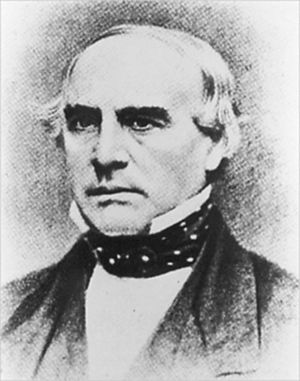John Butterfield (stagecoach company founder) facts for kids
John Butterfield (1801–1869) was a very important person in the history of transportation in the United States during the mid-1800s. He started many companies, including American Express, which is still a big company today. He also created the Butterfield Overland Mail Company. This was the longest stagecoach line in the world! It ran from 1858 to 1861 and helped connect the new state of California with the rest of the country.
Contents
John Butterfield's Early Life
John Butterfield was born on November 18, 1801, in a town called Berne, New York. His family had come to America from England way back in 1638. John didn't go to school for very long. He started working in the transportation business when he was quite young.
He began as a driver for a company in Albany, New York. Later, he moved to Utica, New York. There, he helped gather passengers for stagecoaches. By 1827, John started his own small business. He worked hard and soon had his own stagecoach lines.
Growing His Transportation Business
John Butterfield's business grew quickly. He focused on routes that went north and south from his home base in Utica, New York. At the peak of stagecoach travel, he had about 40 different lines! These lines stretched from Utica all the way to places like Ogdensburg in the north and down to Pennsylvania in the south.
Expanding Beyond Stagecoaches
John didn't stop at stagecoaches. He also got involved with other ways of moving people and goods.
- He invested in boats that traveled on the Erie Canal.
- He owned steamboats on Lake Ontario.
- He helped build plank roads, which were special roads made of wooden planks.
- He even started the first street railroads in Utica.
- He played a big part in building the Black River and Southern railroads.
When the electric telegraph was invented, John saw its potential. He joined others to create the New York, Albany and Buffalo Telegraph Company. He was truly a pioneer, helping transportation grow from simple stagecoaches to the faster trains we know today.
Starting American Express
John Butterfield realized that his many transportation companies could also be used to ship packages quickly. In 1849, he started an express company called Butterfield, Wasson & Co. This company was one of the first to see how profitable it could be to deliver goods fast.
His company was very successful. Later, this business became known as the American Express Company. It grew into one of the biggest companies in the country.
Other business owners in New York also started their own express companies. These companies, like Wells & Co. and Livingston, Fargo & Co., sometimes used Butterfield's large transportation network. John Butterfield saw that it would be better if these companies worked together. So, in 1850, the three companies combined to form The American Express Company.
The new company had two main parts. One part, called Wells, Butterfield & Co., handled express business from Buffalo, New York, to the east. The other part, Livingston, Fargo & Co., managed express business from Buffalo to St. Louis, Missouri.
The Famous Butterfield Overland Mail Company
The Butterfield Overland Mail Company was a huge project. It cost a lot of money, about $3.5 million, to build and keep running. Some of this money came from banks connected to other express companies, like Adams Express and Wells, Fargo & Co. Express.
William B. Dinsmore, who was president of Adams Express Co., was a major investor and the Vice President of Butterfield's Overland Mail Company. Wells, Fargo & Co. Express was also a big lender because they were very successful.
Who Owned the Overland Mail?
It's important to know that the Butterfield Overland Mail Company was owned by its stockholders. The official contract for the company, which lasted six years (1858 to 1864), does not show Wells, Fargo & Co. as an owner.
Wells Fargo & Company was mainly an express company. Their main goal was to quickly ship items for people who paid for the service. They were not primarily in the business of running stagecoaches.
Some historians in the 1960s thought that Wells, Fargo & Co. was a direct part of Butterfield’s Overland Mail Company. However, there was no clear proof. A historian named Ralph Moody even wrote in his book Stagecoach West that no strong evidence was ever found to show that Wells, Fargo & Co. directly owned the Overland Mail Company before July 1, 1861.
Wells, Fargo & Co. didn't actually get into the stagecoach business until 1867. This was five years after Butterfield's company stopped running on the Southern Overland Trail. At that time, Wells, Fargo & Co. took over another stagecoach line and put their own name on it.
John Butterfield's Legacy
John Butterfield's son, Daniel Adams Butterfield (1831–1901), became a general in the American Civil War. He was also an Assistant U.S. Treasurer. Daniel is famous for creating the bugle call "Taps" in 1862. This tune is often played at military funerals and ceremonies.
John Butterfield was buried in Forest Hill Cemetery in Utica, New York. This was the city where he lived when he started his very first stagecoach line.
Images for kids



